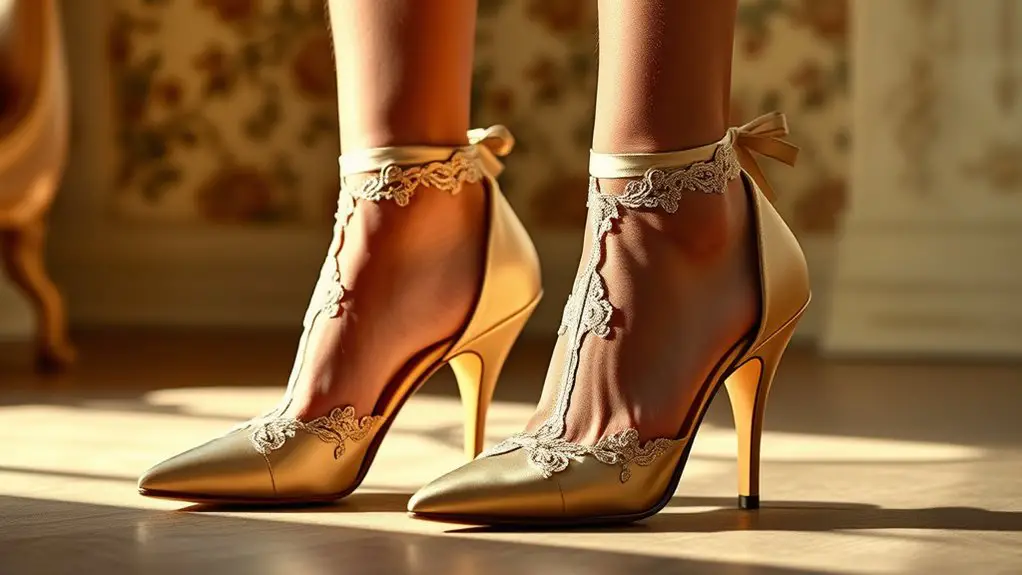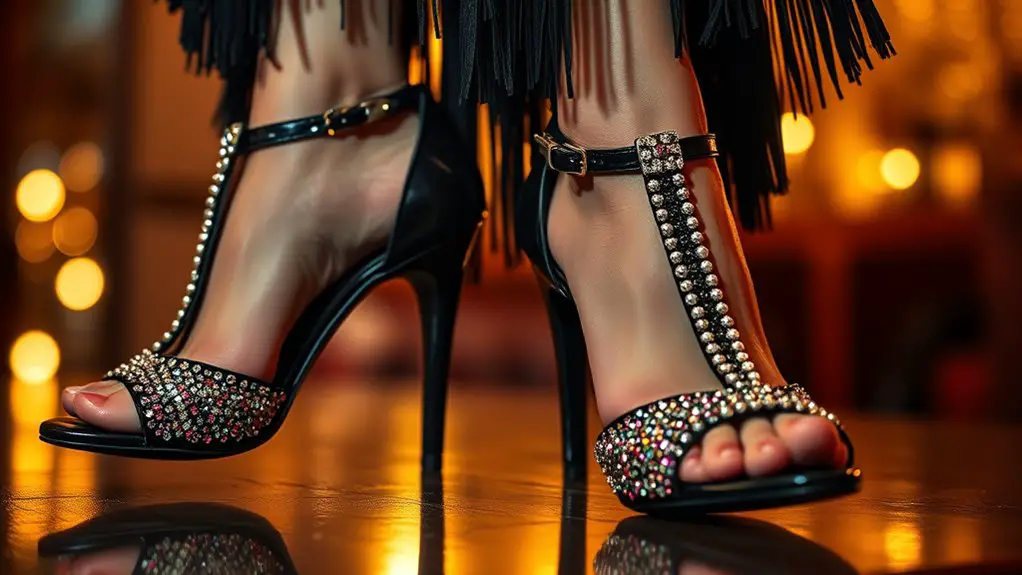When you think of unforgettable heels from period dramas, you’re reminded of how they reflect the era’s elegance and societal shifts. From the delicate designs of the Regency Era to the opulent Victorian stilettos, each shoe tells a story of femininity and status. The flapper styles of the Roaring Twenties and the extravagant footwear inspired by Marie Antoinette further illustrate the evolving tastes in fashion. Uncovering their significance reveals much about the cultural contexts they emerged from.
The Regency Era: a Step Into Elegance

The Regency Era, often synonymous with elegance and sophistication, marked a pivotal shift in fashion, particularly in women’s footwear. During this time, Regency footwear transformed, emphasizing delicate designs and graceful lines that complemented the elegant silhouettes of the dresses. You’d notice that shoes were often crafted from luxurious materials like silk and satin, featuring intricate embellishments such as ribbons and embroidery.
The rise of the empire waist silhouette in dresses called for footwear that was equally refined. Low-cut shoes, often with a slight heel, allowed women to showcase their ankles while maintaining an air of modesty. This era’s shoes were not just functional; they were a statement of status and taste. Their design encouraged a sense of poise and grace, reflecting the social aspirations of the time. As you explore this period, you’ll appreciate how Regency footwear perfectly captured the essence of elegance that defined an entire era.
Victorian Stilettos: A Touch of Opulence
Victorian stilettos embody a striking blend of elegance and opulence, showcasing intricate designs that often reflect the wealth and status of their wearers. You’ll notice how these heels not only elevate the wearer’s stature but also serve as a symbol of the era’s social dynamics and tastes. Understanding their historical significance reveals much about the cultural values and aesthetic preferences of the Victorian period.
Elegant Design Features
Stilettos from the Victorian era embody an exquisite blend of elegance and opulence, capturing the essence of a time when fashion was a statement of social status. These heels feature elegant silhouettes that gracefully elongate the leg, making them a favorite among the elite. Intricate embellishments, such as lace, embroidery, and beading, transform each pair into a work of art. The delicate craftsmanship reflects the era’s attention to detail and luxury, ensuring that every stiletto was not just footwear, but a symbol of refinement. Rich materials like silk and velvet further enhance their allure, while ornate heels provide both height and stability. When you see these Victorian stilettos, you’re witnessing a perfect marriage of beauty and sophistication that defined an era.
Historical Significance Explained
While footwear might seem like a mere accessory, the significance of Victorian stilettos transcends their aesthetic appeal, reflecting the intricate relationship between fashion and societal norms of the era. In the historical context of the Victorian period, these heels symbolize:
- Status and Wealth: The elaborate designs were often accessible only to the affluent, showcasing their social standing.
- Gender Roles: The exaggerated height emphasized femininity, reinforcing the era’s cultural implications regarding women’s roles as delicate and ornamental.
- Fashion Evolution: Stilettos marked a shift toward more daring designs, paving the way for modern high fashion.
These elements reveal how Victorian stilettos were more than just shoes; they were potent symbols of the cultural dynamics and aspirations of their time.
The Roaring Twenties: Flapper Fashion and Footwear

As the Jazz Age unfolded, the Roaring Twenties ushered in a revolution not just in music and dance, but also in fashion, particularly for women. Flapper fashion emerged as a bold statement against traditional norms, characterized by dropped waistlines and loose silhouettes. Footwear played an essential role in this transformation, with sleek, heeled shoes designed for movement and freedom. You’d often see women donning T-strap or Mary Jane styles, perfectly complementing their flapper accessories like feathered headbands and beaded clutches.
The heels of this era weren’t just functional; they symbolized a newfound independence. With their playful designs and vibrant colors, these shoes encapsulated the spirit of the jazz age. You could easily picture a flapper dancing the Charleston, her heels clicking against the dance floor, embodying the exuberance of a generation enthusiastic to break free from the past. The Roaring Twenties truly reshaped women’s fashion, leaving a lasting impact on style.
The 18th Century: Heels That Made a Statement
In the 18th century, heels took on a bold significance, becoming a symbol of status and style among the elite. These statement footwear pieces were more than mere accessories; they communicated power and prestige. The intricate designs and elevated heights were essential to 18th century fashion, showcasing not just wealth but also artistic craftsmanship.
Heels in the 18th century symbolized elite status, combining artistry and power in their striking designs and heights.
Consider these three defining characteristics of 18th-century heels:
- Materials and Embellishments: Luxurious fabrics and ornate decorations like gemstones elevated the aesthetics.
- Height and Shape: The exaggerated heel height emphasized stature, creating a striking silhouette that demanded attention.
- Cultural Reflection: Heels mirrored societal values, representing the opulence of the aristocracy and their desire for self-expression.
As you explore period dramas, you’ll notice how these heels encapsulate the essence of an era where fashion was an art form, leaving an indelible mark on the world of footwear.
The Influence of Marie Antoinette: Extravagance in Footwear

Marie Antoinette’s reign brought Rococo fashion to its zenith, transforming footwear into a bold statement of extravagance. You can see how her iconic shoe designs, characterized by elaborate embellishments and towering heels, reflected the opulence of her court. These styles not only influenced contemporary trends but also left a lasting mark on the world of fashion, echoing the lavishness of an era defined by excess.
Rococo Fashion Trends
Rococo fashion trends, epitomized by the extravagant style of the 18th century, reveal a fascinating interplay between opulence and footwear, greatly influenced by the iconic figure of Marie Antoinette. The era’s footwear wasn’t just about function; it was a statement of wealth and status. You’d notice:
- Rococo embellishments: Intricate designs adorned heels, making each pair a work of art.
- Flamboyant silhouettes: The exaggerated shapes and heights of shoes enhanced the wearer’s stature, reflecting their social standing.
- Bold colors and patterns: Vivid hues and elaborate motifs dominated footwear, adding to the overall extravagance.
These elements combined to create not just shoes, but masterpieces that encapsulated the essence of Rococo fashion, celebrating both beauty and excess.
Iconic Shoe Designs
Footwear from the era of Marie Antoinette stands out as a defining element of iconic shoe designs, showcasing an unparalleled level of extravagance. These shoes, often adorned with intricate embroidery and luxurious materials, embodied timeless elegance that resonated with the opulence of the French court. The height of the heels and the lavish embellishments weren’t just fashion statements; they carried cultural significance, reflecting the social hierarchies and aspirations of the time. As you look at these designs, you can’t help but appreciate how they influenced modern fashion, echoing the desire for individuality and status. Marie Antoinette’s legacy in footwear remains a reflection of the interplay of style and societal values, leaving an indelible mark on fashionable history.
The 1940s: Practicality Meets Glamour
As wartime constraints shaped fashion, the 1940s became a decade where practicality elegantly intertwined with glamour. The 1940s footwear reflected the resilience of the time, balancing utility with a touch of style. You’ll notice three key elements that defined this era:
Wartime constraints redefined 1940s fashion, blending practicality with glamour in footwear that showcased resilience and style.
- Chunky Heels: Sturdy yet stylish, these heels provided stability for women maneuvering daily life amidst rationing.
- Closed-Toe Designs: Offering a more modest silhouette, closed-toe shoes became popular, aligning with the era’s focus on functionality.
- Leather Materials: With limited resources, leather became the go-to material, ensuring durability while maintaining an elegant appearance.
Wartime fashion didn’t sacrifice femininity; instead, it transformed it. Women embraced these designs, proving that even in tough times, glamour could flourish alongside practicality. The 1940s ultimately set the stage for future footwear trends, showcasing a remarkable blend of resilience and style.
Bridgerton: Modern Takes on Historical Heels
The elegance of the 1940s paved the way for a reinvention of historical heels in modern interpretations, particularly in popular culture. In “Bridgerton,” you see a striking blend of classic styles and contemporary flair that redefines historical footwear. The show’s designers skillfully incorporate lavish embellishments and bold colors, making each pair of heels not just functional but also a statement piece.
Bridgerton fashion embraces the opulence of Regency-era silhouettes while adding a modern twist that resonates with today’s audience. Think stiletto heels adorned with intricate lace and satin, which capture the essence of the period while reflecting current trends.
This fusion not only enhances character portrayal but also invites viewers to appreciate the evolution of footwear. By intertwining historical accuracy with modern aesthetics, “Bridgerton” elevates the significance of heels as symbols of power and femininity, making them unforgettable in the domain of period dramas.
The Great Gatsby: Jazz Age Glamour in Footwear
While immersed in the lavish world of “The Great Gatsby,” you’ll find that the footwear embodies the spirit of the Jazz Age, reflecting both the opulence and the excess of the era. The shoes aren’t just accessories; they’re statements of wealth and style, showcasing the distinctive footwear trends that defined the time.
- T-strap heels: These elegant styles, often adorned with dazzling embellishments, capture the playful yet glamorous essence of Jazz Age parties.
- Mary Janes: With their rounded toes and ankle straps, they evoke a youthful charm, perfect for the carefree spirit of the era.
- Platform shoes: These elevated styles add height and allure, emphasizing the boldness of the characters and the flamboyant lifestyle they lead.
Each pair of shoes tells a story, intertwining fashion with the cultural vibrancy of the 1920s, making them unforgettable icons of the period.
Modern Adaptations: Period Dramas Inspiring Today’s Trends
Although period dramas often transport viewers to bygone eras, they also serve as a wellspring of inspiration for contemporary fashion trends. You might notice how the trendsetting styles featured in these shows resonate in today’s wardrobes. Designers frequently draw from historical aesthetics, merging classic silhouettes with modern sensibilities.
Take, for instance, the elegant heels showcased in “Bridgerton,” which have sparked a resurgence of corset-inspired tops and vibrant colors in current collections. This fashion evolution reflects a desire for both nostalgia and innovation, allowing you to embrace pieces that echo the grace of past eras while remaining stylishly relevant.
As you explore the latest trends, remember how the intricate details and rich textures seen in period dramas influence today’s footwear choices. By incorporating elements from these narratives, modern fashion becomes a dialogue between history and contemporary style, creating a unique blend that feels both timeless and fresh.
Frequently Asked Questions
What Materials Were Commonly Used for Heels in Period Dramas?
Picture a master artisan weaving history into every stitch; in period dramas, heels often emerged from exquisite leather craftsmanship, embodying historical fashion’s elegance. Materials like wood and metal complemented fine leathers, creating timeless silhouettes that captivated audiences.
How Did Heel Heights Vary Across Different Eras?
Heel heights varied considerably across eras; Victorian footwear often featured higher, more structured heels for elegance, while Renaissance styles embraced lower, more practical designs. You’d notice how these shifts reflected social status and changing fashion norms.
Were There Any Societal Implications of Wearing Heels Historically?
Historically, wearing heels signified societal status, reflecting fashion evolution. You’d notice how higher heels often indicated wealth and class, shaping perceptions of femininity and power, while also influencing social dynamics across various eras and cultures.
How Did Footwear Influence Character Development in Period Dramas?
In period dramas, footwear evolves like a character’s journey, symbolizing their status and growth. You’ll notice how shoes reflect societal roles, shaping character symbolism, revealing hidden ambitions, and transforming individuals into icons of their time.
What Are the Most Iconic Heel Styles From Period Dramas?
When you think of iconic heel styles, Victorian elegance and Regency romance come to mind. The delicate, curved heels of the era conveyed social status, while enhancing characters’ grace and poise, adding depth to their narratives.


